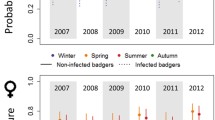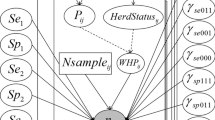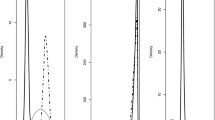Abstract
This article presents hierarchical models for determining infection status and prevalence of infection within a herd given a hypergeometric or binomial sample of animals that have been screened with an imperfect test. Expert prior information on the infection status of the herd, diagnostic test accuracy, and herd prevalence is incorporated into the model. Posterior probabilities versus prior probabilities of infection are presented in the novel form of a curve, summarizing the probability of infection over a range of possible prior probability values. We demonstrate the model with serologic data for Mycobacterium paratuberculosis (Johne’s disease) in dairy herds.
Similar content being viewed by others
References
Bulaga, L. L. (1998), “U.S. Voluntary Johne’s Disease Herd Status Program for Cattle,” in Proceedings of the Annual Meeting of the U.S. Animal Health Association, pp. 420–433.
Cameron, A. R., and Baldock, F. C. (1998a), “A New Probability Formula for Surveys to Substantiate Freedom from Disease,” Preventice Veterinary Medicine, 34, 1–17.
— (1998b), “Two-Stage Sampling in Surveys to Substantiate Freedom for Disease,” Preventive Veterinary Medicine, 34, 19–30.
Cannon, R. M. (2001), “Sense and Sensitivity—Designing Surveys Based on an Imperfect Test,” Preventive Veterinary Medicine, 49, 141–163.
Cannon, R. M., and Roe, R. T. (1982), “Livestock Disease Surveys. A Field Manual for Veterinarians,” Bureau of Range Science, Department of Primary Industry, Australian Government Testing Service, Canberra.
Casella, G., and Berger, R. (2002), Statistical Inference, (2nd ed.), Pacific Grove, CA: Duxbury Press
Collins, M. T., and Sockett, D. C. (1993), “Accuracy and Economics of the USDA-Licensed Enzyme-Linked Immunoassay for Bovine Paratuberculosis,” Journal of the American Veterinary Medical Association, 203, 1456–1463.
Courtney, C. H., and Zeng, Q. (1993), “Sensitivity and Specificity of Two Heartworm Antigen Detection Tests,” Canine Practitioner, 18, 20–22.
Dargatz, D. A., Byrum, B. A., Barber, L. K., Sweeney, R. W., Shulaw, W. P., Jacobsen, R. H., and Stabel, J. R. (2001), “Evaluation of a Commercial ELISA for Diagnosis of Paratuberculosis in Cattle,” Journal of the American Veterinary Medical Association, 218, 1163–1166.
Dubey, J. P., Thulliez, P., Weigel, R. M., Andrews, C. D., Lind, P., and Powell, E. C. (1995), “Sensitivity and Specificity of Various Serologic Tests for Detection of Toxoplasma gondii Infection in Naturally Infected Sows,” American Journal of Veterinary Research, 56, 1030–1036.
Enøe, C., Georgiadis, M. P., and Johnson, W. O. (2000), “Estimation of Sensitivity and Specificity of Diagnostic Tests and Disease Prevalence When the True Disease State is Unknown,” Preventive Veterinary Medicine, 45, 61–81.
Gastwirth, J. L., Johnson, W. O., and Reneau, D. M. (1991), “Bayesian Analysis of Screening Data: Application to AIDS in Blood Donors,” Canadian Journal of Statistics, 19, 135–150.
Geisser, S., and Johnson, W. O. (1992), “Optimal Administration of Dual Screening Tests for Detecting a Characteristic with Special Reference to Low Prevalence Diseases,” Biometrics, 48, 839–852.
Gelfand, A. E., and Smith, A. F. M. (1990), “Sampling-Based Approaches to Calculating Marginal Densities,” Journal of the American Statistical Association, 85, 398–409.
Greiner, M., and Gardner, I. A. (2000), “Epidemiologic Issues in the Validation of Veterinary Diagnostic Tests,” Preventive Veterinary Medicine, 45, 3–22.
Hanson, T. E., Johnson, W. O., and Gardner, I. A. (2003), “Hierarchical Models for Estimating Herd Prevalence and Test Accuracy in the Absence of a Gold-Standard,” Journal of Agricultural, Biological, and Environmental Statistics, 8, 223–239.
Johnson, W. O., and Gastwirth, J. L. (1991), “Bayesian Inference for Medical Screening Tests: Approximations Useful for the Analysis of AIDS Data,” Journal of the Royal Statistical Society, Series B, 53, 427–439.
Johnson, W. O., Gastwirth, J. L., and Pearson, L. M. (2001), “Screening Without a Gold Standard: The Hui-Walter Paradigm Revisited,” American Journal of Epidemiology, 153, 921–924.
Joseph, L., Gyorkos, T. W., and Coupal, L. (1995), “Bayesian Estimation of Disease Prevalence and Parameters for Diagnostic Tests in the Absence of a Gold Standard,” American Journal of Epidemiology, 141, 263–272.
Suess, E. A., Gardner, I. A., and Johnson, W. O. (2002), “Hierarchical Bayesian Model for Prevalence Inferences and Determination of a Country’s Status for an Animal Pathogen,” Preventive Veterinary Medicine, 55, 155–171.
Sweeney, R. W., Whitlock, R. H., and Buckley, C. L. (1995), “Evaluation of a Commercial Enzyme-Linked Immunosorbent Assay for the Diagnosis of Paratuberculosis in Dairy Cattle,” Journal of Veterinary Diagnostic Investigation, 7, 488–493.
Tierney, L. (1994), “Markov Chains for Exploring Posterior Distributions,” The Annals of Statistics, 22, 1701–1762.
Whitlock, R. H., Wells, S. J., Sweeney, R. W., and Van Tiem, J. (2000), “ELISA and Fecal Culture for Paratuberculosis (Johne’s disease); Sensitivity and Specificity of Each Method,” Veterinary Microbiology, 77, 387–398.
Author information
Authors and Affiliations
Corresponding author
Rights and permissions
About this article
Cite this article
Hanson, T.E., Johnson, W.O., Gardner, I.A. et al. Determining the infection status of a herd. JABES 8, 469 (2003). https://doi.org/10.1198/1085711032561
Received:
Revised:
DOI: https://doi.org/10.1198/1085711032561




